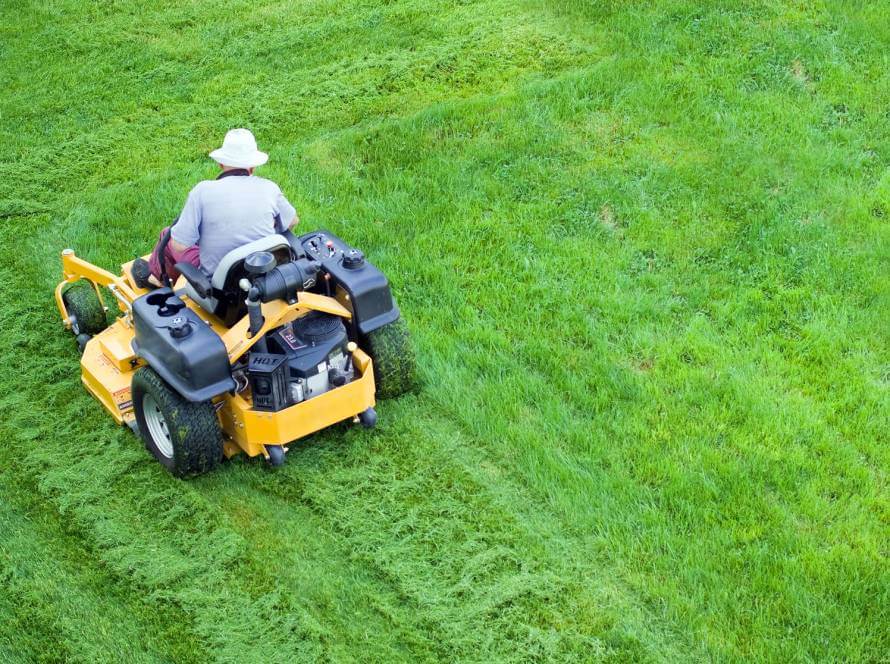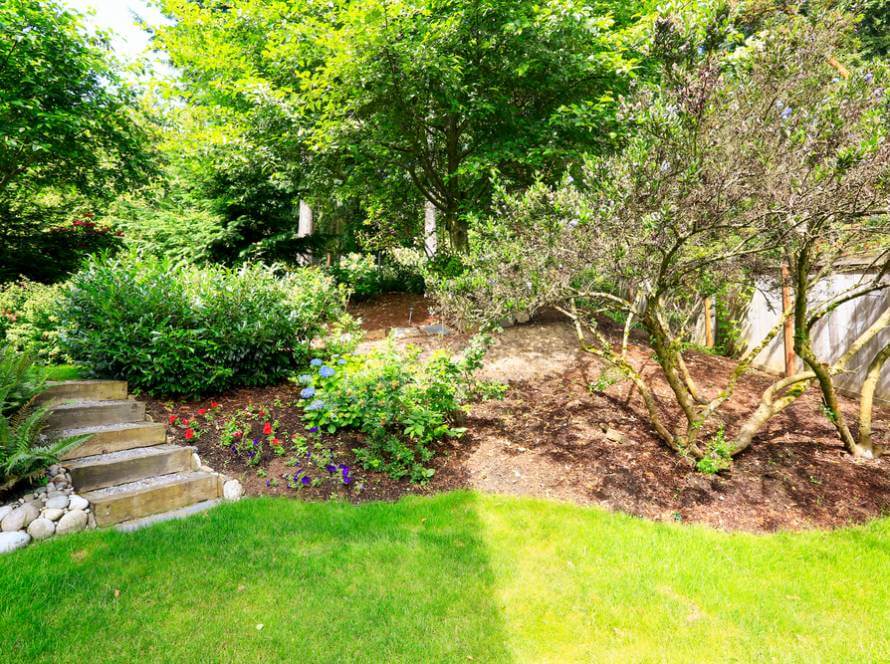Mowing your lawn might seem like one of the simpler tasks of home maintenance, but doing it right can be the difference between a thriving, lush lawn and one that struggles to survive. Grass mowing is not just about cutting grass shorter—it is about maintaining its health, encouraging growth, and creating a landscape that enhances your home’s overall curb appeal. Here at Covenant Landscapes, we recognize the need for each cut, which is why we emphasize the best practices in lawn care, including mowing. In this article, we will provide you with a detailed guide on how to mow your grass.
Understanding Grass Mowing Basics
Grass mowing is more than just an aesthetic practice; it is vital for your lawn’s health. Each mowing session is an opportunity to improve the grass’s health and resilience. Correct mowing promotes thicker growth, discourages weeds, and prevents pests and diseases from taking hold.
The first step in proper lawn mowing is to know your grass type. Different grasses have different needs in terms of mowing height, frequency, and even the type of mower blade used. For example, cool-season grasses such as bluegrass and fescue thrive when cut to about 2.5 to 3.5 inches, while warm-season grasses like Bermuda and zoysia prefer shorter heights.
Mowing Height Matters
A critical aspect of grass mowing is the mowing height. A common mistake is cutting grass too short, a practice often called “scalping,” which can significantly harm the lawn’s health. Scalping makes your lawn vulnerable to diseases and weed invasion due to the stress placed on the grass. Keeping your grass at an optimal height will promote root development, which in turn enhances nutrient uptake and moisture absorption.
Adjusting your mower to the right height for your specific grass type is crucial. During the peak growing season, you might find that your lawn needs more frequent mowing, but remember, never cut more than a third of the grass blade length at one time. This rule of thumb helps prevent stress and keeps your lawn more resilient against environmental challenges.
The Best Time and Conditions for Mowing
Timing and weather conditions play significant roles in effective grass mowing. The best time for mowing is when it is dry. Wet grass not only clumps, causing an uneven cut, but can also spread diseases. Mowing during the early evening or late afternoon is optimal because it avoids the heat of the day, reducing stress on both the mower and your grass.
Moreover, mowing when it is dry minimizes the wear on your mower and prevents tearing and bruising of the grass blades, which can open the door to pests and diseases. If your schedule forces you to mow in the morning, wait until the dew has lifted to start mowing. The simple adjustment can make a significant difference in the health of your lawn.
Technique and Equipment
The technique you use to mow your lawn impacts its health and appearance. Always use sharp blades; dull blades tear the grass rather than cutting it cleanly, which can lead to discoloration and disease. Mower blade sharpness might seem like a minor detail, but it is actually critical for preventing damage to the grass.
Altering your mowing pattern with each session is another advantageous practice. This prevents the grass from leaning in one direction and promotes more upright growth. Additionally, the method prevents the formation of ruts from the mower’s wheels, which can compact the soil and inhibit root development.
When it comes to equipment, choosing the right mower for your lawn size and type of grass is essential. For smaller lawns, a push mower might be adequate, while larger areas might require a powered mower to efficiently handle the space without causing exhaustion.
Advanced Mowing Strategies: Beyond the Basics
Once you have mastered the basic principles of mowing, such as cutting height, timing, and pattern—it is time to explore more advanced techniques that can significantly contribute to the health and resilience of your lawn.
- Mulching vs. Bagging
Many modern mowers come with mulching capabilities, which can be incredibly beneficial for your lawn. Mulching mowers cut the grass clippings into fine pieces that fall back onto the lawn, where they decompose and return nutrients to the soil. Natural fertilization helps to enrich the soil and keep your lawn healthy. On the other hand, bagging your clippings is generally recommended if the grass is overly long or if you are dealing with leafy weeds that you do not want to redistribute onto your lawn.
- GrassCycling
If your mower does not have a mulching feature, you can still practice grasscycling by leaving the clippings on the lawn after mowing. Ensure the clippings are short enough not to smother the grass, as long clippings can block sunlight and moisture from reaching the lawn’s surface. The practice is especially effective during the growing season when grass needs more nutrients.
- Dealing with Weeds and Obstacles
Mowing can be a strategic tool in weed control. Regular mowing, at the right height, helps maintain a dense turf that competes effectively against weeds. However, for areas with persistent weeds, additional strategies might be necessary. When mowing around trees, garden beds, or other obstacles, be careful not to damage the bark of trees or disturb the edges of your garden. Damage from mower blades can make trees vulnerable to disease and pests.
Mowing Pattern Techniques
The pattern in which you mow your lawn can have significant aesthetic and health implications for your grass. While alternating your mowing pattern each time is a good practice, there are specific patterns that can help boost the effectiveness of your mowing sessions:
- Spiral Mowing – For smaller or irregularly shaped lawns, mowing in a spiral pattern can help make sure even cutting and efficient coverage. Start from the outer edge and work your way inwards, gradually reducing the circle until you cover the entire area.
- Striping – To achieve a professionally striped look, use a mower with a roller or modify your mower to add one. The roller bends the grass as you mow, creating light and dark stripes. For the best effect, mow in straight lines and alternate the direction with each mowing session.
- Mowing Slopes – Mowing slopes requires special care to prevent accidents and ensure an even cut. Always mow across the slope, never up and down, to reduce the risk of the mower tipping over. If the slope is too steep, consider using a string trimmer to maintain these areas safely.
Seasonal Mowing Considerations
Different seasons require adjustments to your mowing practices to adapt to changing growth rates and environmental conditions.
- Spring: In spring, focus on revitalizing your lawn. Start with a slightly lower mowing height to remove dead winter growth and gradually increase the height as the season progresses. IIt encourages deeper root growth, which helps the grass withstand the upcoming summer heat.
- Summer: During hot summer months, raise the mowing height to help the grass retain moisture. The taller blades provide shade to the soil, reducing water evaporation and protecting roots from the intense sun. Guarantee your mower blades are extra sharp in summer to prevent tearing, which can lead to dehydration and sun damage.
- Fall: As growth slows in the fall, you can lower the mower’s height slightly, but avoid cutting the grass too short. This is also a good time to aerate and oversee your lawn to prepare it for the next growing season.
- Winter: Generally, mowing is not required in winter, but in warmer climates, if mowing is necessary, confirm that it is infrequent and set the blades to a higher cut to minimize stress on the grass during cooler temperatures.
Maintaining Your Mowing Equipment
Regular Cleaning
After each mow, take the time to clean your mower. Remove any grass clippings, dirt, and debris from the blades and the underside of the mower deck. It prevents the spread of lawn diseases and knows that your mower operates efficiently.
Blade Sharpening
Dull mower blades tear rather than cut grass blades, resulting in jagged edges that can turn brown and increase the risk of disease. Sharpen your mower blades at least twice during the mowing season or more frequently if you notice any tearing of the grass blades.
Engine Maintenance
For gas-powered mowers, regular engine maintenance is vital. Check the oil level, air filter, and spark plug according to the manufacturer’s instructions, and make any necessary replacements or adjustments. Well-maintained engines run more smoothly and extend the lifespan of your mower.
Common Mowing Mistakes to Avoid
Even with the best intentions, certain mowing practices can adversely affect the health and growth of your lawn. Here are some common mistakes to watch out for:
- Mowing Too Frequently: While it is important to mow regularly, over-mowing can stress the grass, especially during periods of low growth or extreme weather conditions. Always base the frequency of mowing on the growth rate of the grass, rather than on a fixed schedule.
- Ignoring Weather Conditions: Avoid mowing in extreme weather conditions such as during a drought, when the lawn is stressed, or immediately after heavy rainfall, when the lawn is wet. These conditions can lead to poor cuts and might damage both your lawn and mower.
- Cutting in the Same Direction: As mentioned earlier, varying your mowing pattern each time is needed to prevent ruts and encourage grass to grow upright. Regularly changing your mowing direction also secures an even and healthy cut across your entire lawn.
- Neglecting Mower Height Adjustment: Many people set their mower at a single height and forget it. However, adjusting the cutting height throughout the growing season is necessary to match the changing conditions and needs of your grass.
Cultivating a Healthy Lawn with Proper Grass Mowing
Grass mowing is more than just a routine chore; it is a fundamental aspect of lawn care that requires attention to detail and a knowledge of your lawn’s specific needs. By implementing the right mowing techniques, maintaining your equipment, and avoiding common pitfalls, you can significantly support the health and aesthetic appeal of your lawn.
Proper mowing contributes to a robust, dense turf that is not only beautiful to look at but also more capable of withstanding pressures from pests, diseases, and weather fluctuations. Remember, each cut is an opportunity to improve the health of your grass, promoting a landscape that is vibrant and full of life.
For homeowners seeking full-service lawn care for their landscapes, including lawn mowing services and law maintenance, understanding these mowing principles is essential. By taking the time to mow correctly, you guarantee that your lawn remains a testament to your dedication to a beautiful and healthy outdoor space.



